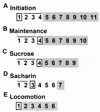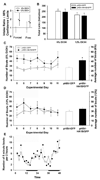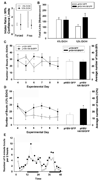Overexpression of 5-HT(1B) mRNA in nucleus accumbens shell projection neurons differentially affects microarchitecture of initiation and maintenance of ethanol consumption
- PMID: 20843634
- PMCID: PMC3003941
- DOI: 10.1016/j.alcohol.2010.07.010
Overexpression of 5-HT(1B) mRNA in nucleus accumbens shell projection neurons differentially affects microarchitecture of initiation and maintenance of ethanol consumption
Abstract
Serotonin 1B (5-HT(1B)) heteroreceptors on nucleus accumbens shell (NAcSh) projection neurons have been shown to enhance the voluntary consumption of alcohol by rats, presumably by modulating the activity of the mesolimbic reward pathway. The present study examined whether increasing 5-HT(1B) receptors expressed on NAcSh projection neurons by means of virus-mediated gene transfer enhances ethanol consumption during the initiation or maintenance phase of drinking and alters the temporal pattern of drinking behavior. Animals received stereotaxic injections of viral vectors expressing either 5-HT(1B) receptor and green fluorescent protein (GFP) or GFP alone. Home cages equipped with a three-bottle (water and 6 and 12% ethanol) lickometer system recorded animals' drinking behaviors continuously, capturing either initiation or maintenance of drinking behavior patterns. Overexpression of 5-HT(1B) receptors during initiation increased consumption of 12% ethanol during both forced-access and free-choice consumption. There was a shift in drinking pattern for 6% ethanol with an increase in number of drinking bouts per day, although the total number of drinking bouts for 12% ethanol was not different. Finally, increased 5-HT(1B) expression induced more bouts with very high-frequency licking from the ethanol bottle sippers. During the maintenance phase of drinking, there were no differences between groups in total volume of ethanol consumed; however, there was a shift toward drinking bouts of longer duration, especially for 12% ethanol. This suggests that during maintenance drinking, increased 5-HT(1B) receptors facilitate longer drinking bouts of more modest volumes. Taken together, these results indicate that 5-HT(1B) receptors expressed on NAcSh projection neurons facilitate ethanol drinking, with different effects during initiation and maintenance of ethanol-drinking behavior.
Copyright © 2011 Elsevier Inc. All rights reserved.
Figures






Similar articles
-
Increased expression of 5-HT1B receptors in rat nucleus accumbens via virally mediated gene transfer increases voluntary alcohol consumption.Alcohol. 2006 Feb;38(2):73-9. doi: 10.1016/j.alcohol.2006.04.003. Alcohol. 2006. PMID: 16839853
-
5-HT(1B) receptors in nucleus accumbens efferents enhance both rewarding and aversive effects of cocaine.Eur J Neurosci. 2007 May;25(10):3125-31. doi: 10.1111/j.1460-9568.2007.05568.x. Epub 2007 May 17. Eur J Neurosci. 2007. PMID: 17509084
-
Increased expression of 5-HT(1B) receptors by Herpes simplex virus gene transfer in septal neurons: New in vitro and in vivo models to study 5-HT(1B) receptor function.Brain Res Bull. 2008 Jul 1;76(4):439-53. doi: 10.1016/j.brainresbull.2008.01.015. Epub 2008 Feb 12. Brain Res Bull. 2008. PMID: 18502320 Free PMC article.
-
5-HT1B mRNA expression after chronic social stress.Behav Brain Res. 2011 Oct 31;224(2):350-7. doi: 10.1016/j.bbr.2011.06.016. Epub 2011 Jun 21. Behav Brain Res. 2011. PMID: 21718722 Free PMC article.
-
Animal models of alcoholism: neurobiology of high alcohol-drinking behavior in rodents.Crit Rev Neurobiol. 1998;12(4):339-69. doi: 10.1615/critrevneurobiol.v12.i4.40. Crit Rev Neurobiol. 1998. PMID: 10348615 Review.
Cited by
-
A role for reward valuation in the serotonergic modulation of impulsivity.Psychopharmacology (Berl). 2021 Nov;238(11):3293-3309. doi: 10.1007/s00213-021-05944-2. Epub 2021 Aug 14. Psychopharmacology (Berl). 2021. PMID: 34390360 Free PMC article.
-
A Role for Serotonin in Modulating Opposing Drive and Brake Circuits of Impulsivity.Front Behav Neurosci. 2022 Feb 17;16:791749. doi: 10.3389/fnbeh.2022.791749. eCollection 2022. Front Behav Neurosci. 2022. PMID: 35250501 Free PMC article. Review.
-
Reverse pharmacogenetic modulation of the nucleus accumbens reduces ethanol consumption in a limited access paradigm.Neuropsychopharmacology. 2014 Jan;39(2):283-90. doi: 10.1038/npp.2013.184. Epub 2013 Aug 1. Neuropsychopharmacology. 2014. PMID: 23903031 Free PMC article.
-
Recent progress in understanding the pathophysiology of post-traumatic stress disorder: implications for targeted pharmacological treatment.CNS Drugs. 2013 Mar;27(3):221-32. doi: 10.1007/s40263-013-0051-4. CNS Drugs. 2013. PMID: 23483368 Free PMC article. Review.
-
Role of 5-hydroxytryptamine 1B (5-HT1B) receptors in the regulation of ethanol intake in rodents.J Psychopharmacol. 2013 Jan;27(1):3-12. doi: 10.1177/0269881112463126. Epub 2012 Oct 31. J Psychopharmacol. 2013. PMID: 23118018 Free PMC article. Review.
References
-
- Alen F, Moreno-Sanz G, Isabel de Tena A, Brooks RD, Lopez-Jimenez A, Navarro M, Lopez-Moreno JA. Pharmacological activation of CB1 and D2 receptors in rats: predominant role of CB1 in the increase of alcohol relapse. Eur. J. Neurosci. 2008;27:3292–3298. - PubMed
-
- Badawy AA. Tryptophan metabolism in alcoholism. Adv. Exp. Med. Biol. 1999;467:265–274. - PubMed
-
- Balfour DJ. The neuronal pathways mediating the behavioral and addictive properties of nicotine. Handb. Exp. Pharmacol. 2009:209–233. - PubMed
-
- Barot SK, Ferguson SM, Neumaier JF. 5-HT(1B) receptors in nucleus accumbens efferents enhance both rewarding and aversive effects of cocaine. Eur. J. Neurosci. 2007;25:3125–3131. - PubMed
-
- Bell RL, Rodd ZA, Sable HJ, Schultz JA, Hsu CC, Lumeng L, Murphy JM, McBride WJ. Daily patterns of ethanol drinking in peri-adolescent and adult alcohol-preferring (P) rats. Pharmacol. Biochem. Behav. 2006;83:35–46. - PubMed
Publication types
MeSH terms
Substances
Grants and funding
LinkOut - more resources
Full Text Sources
Medical

